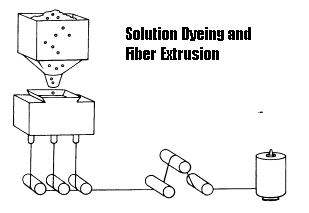|
solution
dyed carpet
Solution Dyed Carpet
Solution dyeing is a yarn coloration
process in which pigment is added to the polymer melt before the fiber
is extruded into yarn. The color, therefore, is an inherent part of the yarn
itself.
Although solution dyeing does not offer
as wide a color selection as other dye methods, its colors are the most
permanent. Solution dyed yarn is highly resistant to color loss through
fading from sunlight, ozone, or harsh cleaning agents and bleach. The
solution dyeing process is, in addition, environmentally friendly and
efficient, using little water or energy.
There are two basic extrusion processes: 1) a one-step/ continuous operation process that
creates heathered solution dyed yarns; and
2) a two-step process batch operation creating solution dyed singles
that may be air entangled, twisted, or twisted and heatset. In a one-step operation,
resin polymer and color chips are poured into a hopper that feeds into the extruder. A
typical formula for Type 6 nylon is 94% nylon 6 polymer and 6% color
concentrate. The extruder is a long narrow cylinder with heat bands
along its exterior. These heat bands melt the polymer while a turning
auger or screw blends the resin and color concentrate. The auger is
specific to the type of fiber being extruded polypropylene, nylon 6, or
nylon 6,6. The molten polymer is forced through small openings of a
spinnerette. The speed of the pump forcing the yarn through the
spinnerette determines the denier of the yarn by controlling the number
of grams of the resin and color concentrate combination fed through at a
specified rate. The shape of the spinnerette openings determines the
final fiber shape, such as delta, tri-lobal, or hollow filament. As the
liquid exits the spinnerette, it is solidified, using cool air in a
quenching process. Lubricants and antimicrobial agents are then added. A drawing process
stretches the yarn aligning its molecules. A texturizer joins and crimps the filaments
using high air pressure and temperature. The yarn then moves into a tack
jet that knots the bundle at short intervals using a process similar to
air entangling. The finished yarn is wound onto cones and is ready for
use in carpet production.
In a two-step process, the yarn goes through extrusion, quenching, and the process of
adding the lubricants and antimicrobial in a continuous operation. The singles are then
moved to another area for the draw texturing process that yields a bulk
continuous filament. The yarn is then wound onto cones and is ready for
air entangling, twisting, or twisting and heatsetting before use in
actual carpet production.
See Also:
continuous dyeing |
beck dyeing |
skein dyeing |
space
dyeing
©2010 FloorBiz, Inc. All Rights Reserved
Flooring |
Flooring Guide |
Flooring Info |
Flooring Forum
| |
